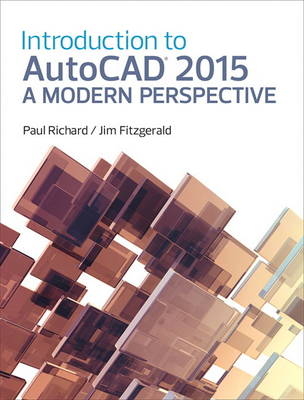
Introduction to AutoCAD 2015
Peachpit Press Publications (Verlag)
978-0-13-314479-6 (ISBN)
- Titel ist leider vergriffen;
keine Neuauflage - Artikel merken
Features:
AutoCAD’s 2-D tools–are presented from the basic concepts to the most powerful tools used in design and engineering.
· Presents material (in seven parts) that advances with complexity.
· Introduces AutoCAD, drafting skills, editing techniques, working with complex objects, annotating drawings, outputting your work, and advanced drawing and construction methods.
Advanced drawing and construction methods–appear after teaching the tools used in design and engineering.
· Explains blocks and block attributes, working with external references, and file management and object linking and embedding.
A “Quick Start” chapter–appears early in the text (see Chapter 2).
· Allows students to get up to speed in no time to create and even plot AutoCAD drawings.
· References corresponding chapters later in the book, allowing readers to delve into topics at their own pace and level.
Chapter Objectives–provide a bulleted list of key concepts for each chapter.
· Provides students with a roadmap of important concepts and practices that will be introduced in the chapter.
Key Terms–highlight important vocabulary throughout.
· Defines key terms in the margins and in more detail in the Glossary at the end of the book.
Command Grids–appear in the margin alongside the discussion of the command.
· Presents a visual of the action options using either: Standard Toolbar, Pull-Down Menu, Command Line, or Command Alias, ensuring that students are in the right place at the right time, correctly following the authors’ direction.
Discipline Icons–identify whether the project applies to a General, Mechanical, Architectural, Electrical, Plumbing/HVAC, or Civil field.
· Enables instructors to quickly select homework assignments that will appeal to the varying interests of their students.
· Allows students to work on projects that have the most interest and relevance to their own course of study.
Icon Flags–highlight features that are new to the latest version of the AutoCAD software.
· Creates a quick “study guide” for instructors and students who need to familiarize themselves with the newest features of the software.
Tips, Notes, and For More Details Boxes–appear throughout the text.
· Highlights additional information for students.
In-text exercises–appear throughout the chapters.
· Provides students with step-by-step walk-through activities.
· Gives students immediate practice and reinforcement of newly learned skills.
Chapter projects organized by discipline–provide additional challenges that require students to use all the commands and skills they have learned. Offers projects from a variety of disciplines including mechanical, architectural, electrical, civil.
Profesional Features:
Chock full of hands-on exercises, this book addresses advances in technology and introduces students to 2-dimensional drawing skills and commands using the current release of AutoCAD 2015.
· Introduces AutoCAD, drafting skills, editing techniques, working with complex objects, annotating drawings, outputting your work, and advanced drawing and construction methods.
· Pedagogy reinforces learning objectives throughout–with chapter objectives; key term definitions; command grids concisely offer multiple ways of achieving task at hand; “New” in this version icons highlight new software features quickly; Discipline icons identify the field of study throughout.
· Hands-on exercises appear throughout the text to reinforce learning and end-of-chapter projects require students to demonstrate a full understanding of the concepts presented in the chapter.
Paul Richard (Portland, Oregon) has worked in the CAD field for almost 30 years. Paul started his career as a CAD Drafter in 1985 and has since worked his way up through the ranks of the industry, holding positions as a CAD Designer, CAD Manager, and, most recently, CAD Software Developer and author. When not sitting in front of a computer, Paul likes to ride and work on motorcycles. Originally from Pittsburgh, Pennsylvania, he has lived in Portland, Oregon since 1992.
Part One An Introduction to AutoCAD
Chapter 1 Introduction to AutoCAD
Chapter 2 Quick Start Tutorial
Part Two Drafting Skills: Drawing with AutoCAD
Chapter 3 Controlling the Drawing Display
Chapter 4 Basic Drawing Commands
Chapter 5 Drawing Tools and Drafting Settings
Chapter 6 Managing Object Properties
Part Three Understanding Editing Techniques: Basics Through Advanced
Chapter 7 Basic Editing Techniques
Chapter 8 Advanced Editing Techniques
Part Four Working with Complex Objects
Chapter 9 Drawing and Editing Complex Objects
Chapter 10 Pattern Fills and Hatching
Part Five Annotating Drawings
Chapter 11 Adding Text
Chapter 12 Working with Tables
Chapter 13 Dimensioning Drawings
Part Six Outputting Your Work
Chapter 14 Managing Paper Space Layouts
Chapter 15 Plotting and Publishing
Part Seven Advanced Drawing and Construction Methods
Chapter 16 Blocks and Block Attributes
Chapter 17 Working with External References
Chapter 18 Drawing Management Tools and Utilities
Appendix A
Drafting Standards Overview
Appendix B
Command Reference
Appendix C
Command Aliases
Appendix D
System Variables
Appendix E
Express Tools
Glossary
Index
| Erscheint lt. Verlag | 25.9.2014 |
|---|---|
| Verlagsort | Berkeley |
| Sprache | englisch |
| Maße | 211 x 274 mm |
| Gewicht | 1740 g |
| Themenwelt | Mathematik / Informatik ► Informatik ► Software Entwicklung |
| Informatik ► Weitere Themen ► CAD-Programme | |
| ISBN-10 | 0-13-314479-8 / 0133144798 |
| ISBN-13 | 978-0-13-314479-6 / 9780133144796 |
| Zustand | Neuware |
| Informationen gemäß Produktsicherheitsverordnung (GPSR) | |
| Haben Sie eine Frage zum Produkt? |
aus dem Bereich


